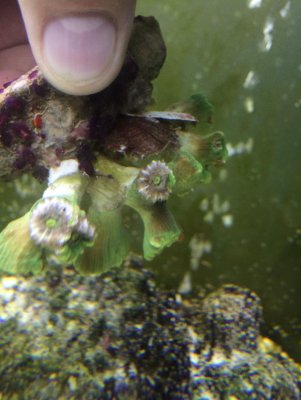So here's my way of doing an iodine dip. This is a general info write-up, and won't be targeting any specific illness. That said, it's the same basic way I do it regardless of what I'm dipping for, or what coral I'm dipping, only thing that varies is the time I leave things in, and the concentration of the iodine.
I typically dip LPS's and Zs&Ps depending on what's affecting them. If I don't know exactly what it is, the first dip I try is an iodine to perk them back up. I've never dipped SPS's this way on a consistent enough basis to tell you what results you'll get out of it for them, please feel free to add info if you have!
%<-GPS
Probably one of the most important pieces: The Iodine! I use CVS brand Povidone-Iodine, for all purposes that I've found, it's identical to Lugol's Solution. That said, I don't dose it to the tank, and if you choose to-blame someone else if it messes things up :angel:
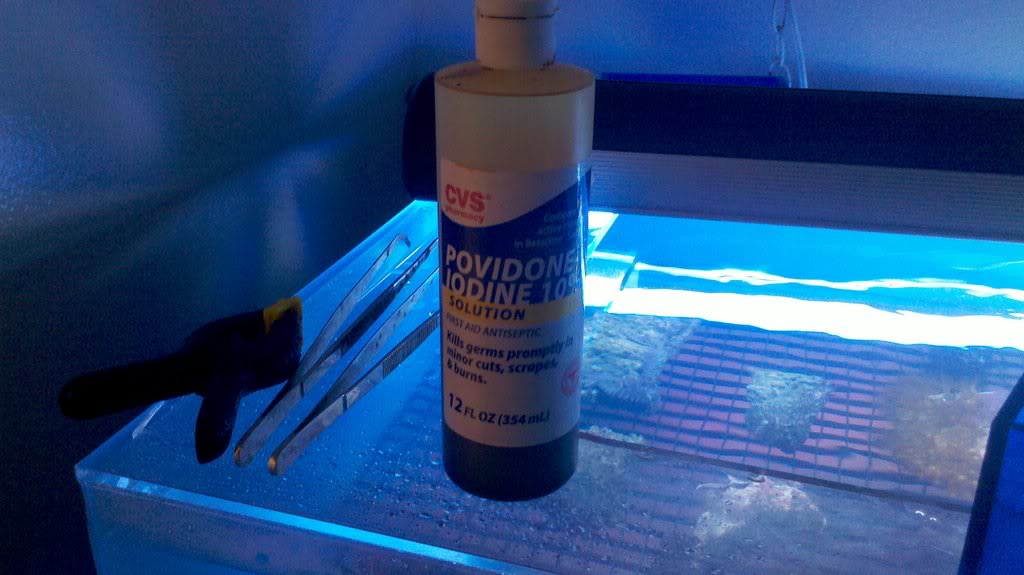
Next up is the dipping container- I know a lot of people like to know exact numbers in terms of cups of water and what not, sorry, I don't do it that way, so you'll just have to bear with me. Oh, and the R's stand for 'reef' so we know it's been used for doing dips and may have weird chemicals (before we use it for soup when we've run out of dishes...)
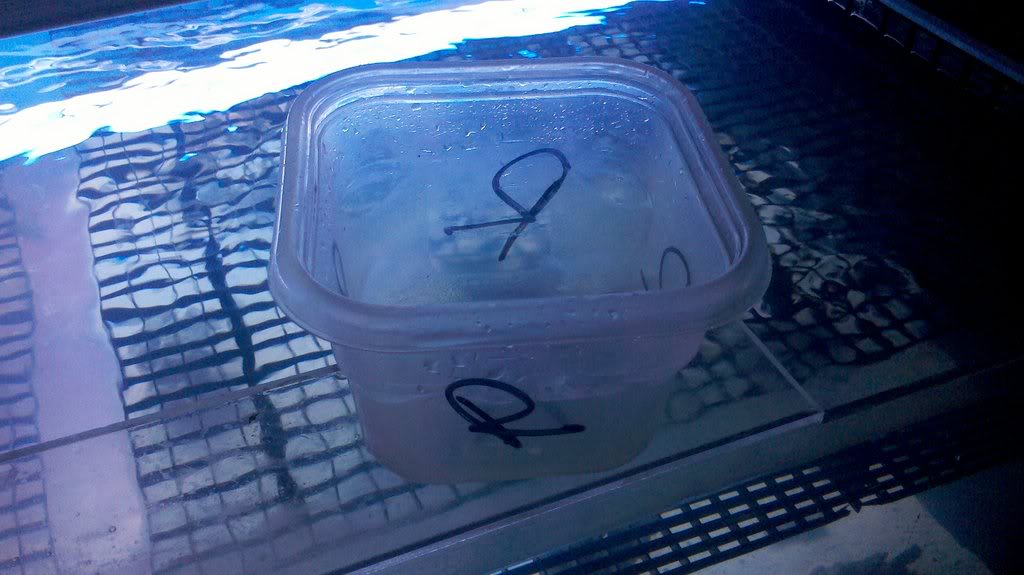
Filled with water from the tank that the coral to be dipped came from, or is going into (if transferring to a new tank, I use the new tanks water)
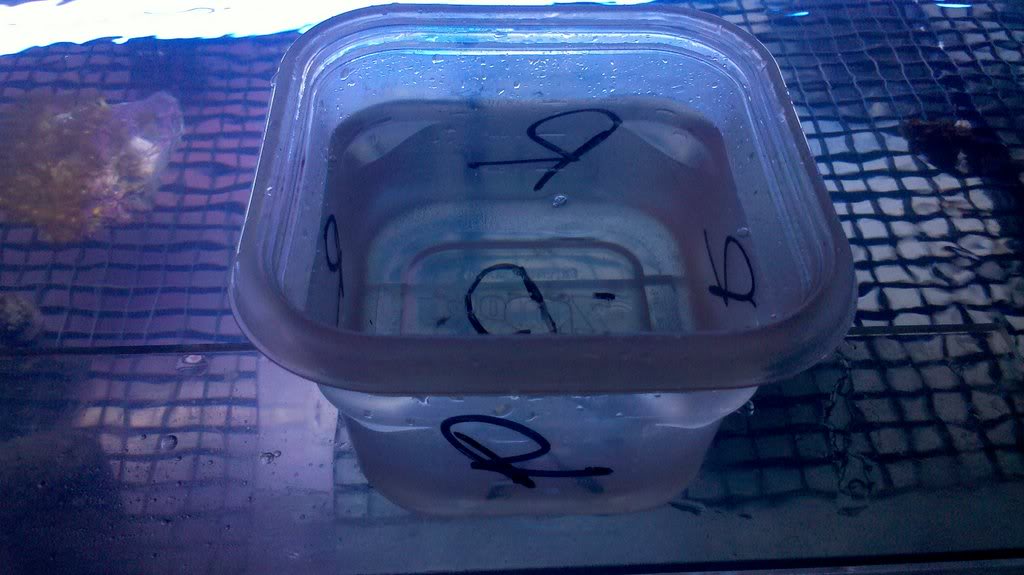
Adding the iodine. I measure based on 'darkness' of the mixture, not on any specific drop count. For zoa's I go black- so dark you can't see through it. For chalices/LPSs, I'll typically go a little lighter, to the point that you could maybe just see through it under lighting. If the LPS is looking like a goner, I'll give it a stronger dose figuring "what's the worst that can happen at this point..." Sometimes it works, sometimes it doesn't
So anyways- adding the iodine, then stir in with either a spoon (i use a pair of long tweezers) or a turkey baster will work- CAUTION iodine stains really well, and you don't want it in your tank at these levels, so be careful around the tank and any precious clothing.
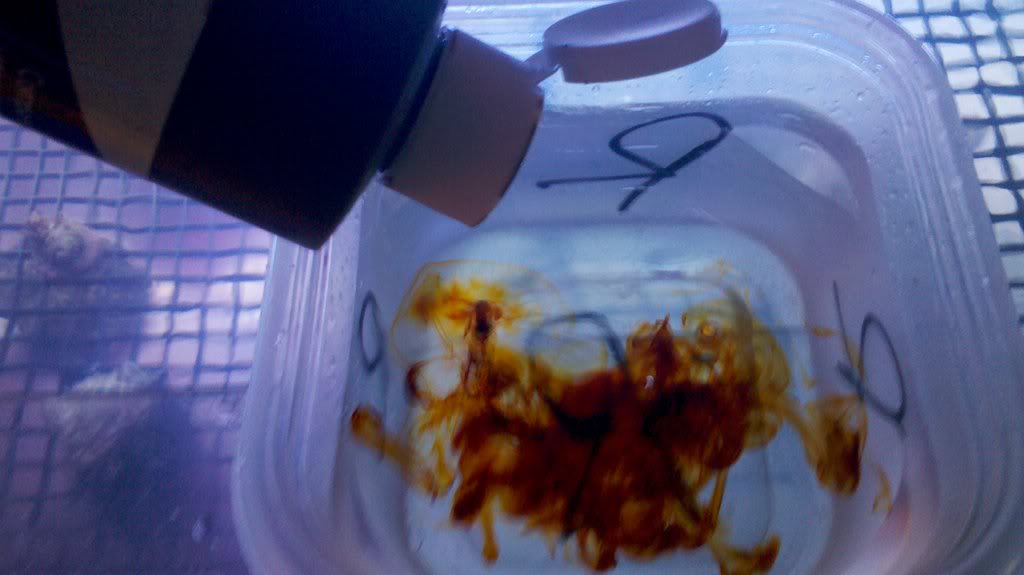
Stirring...
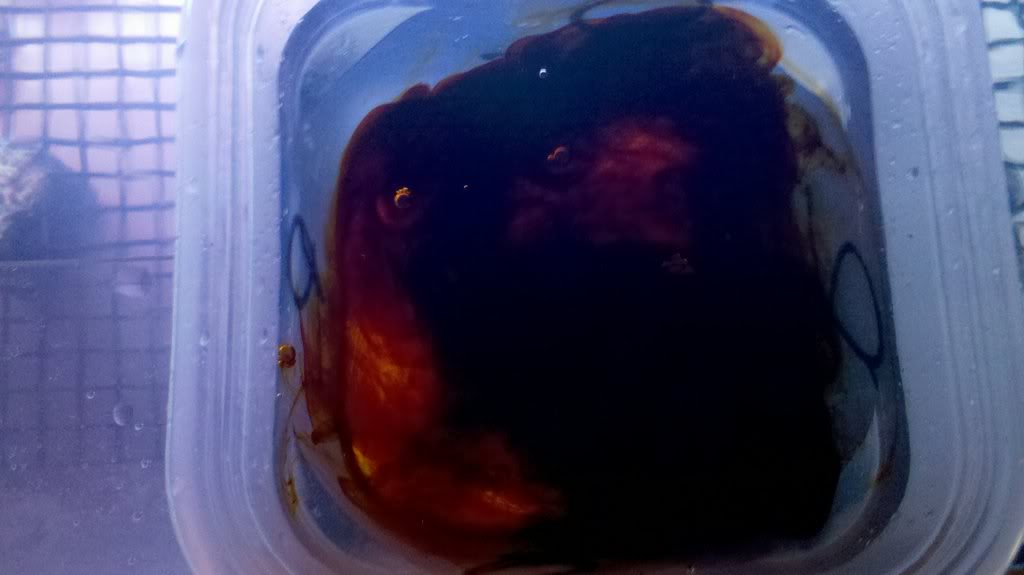
Pair of metal tweezers extending all the way to the bottom of the container. yes, THAT dark.
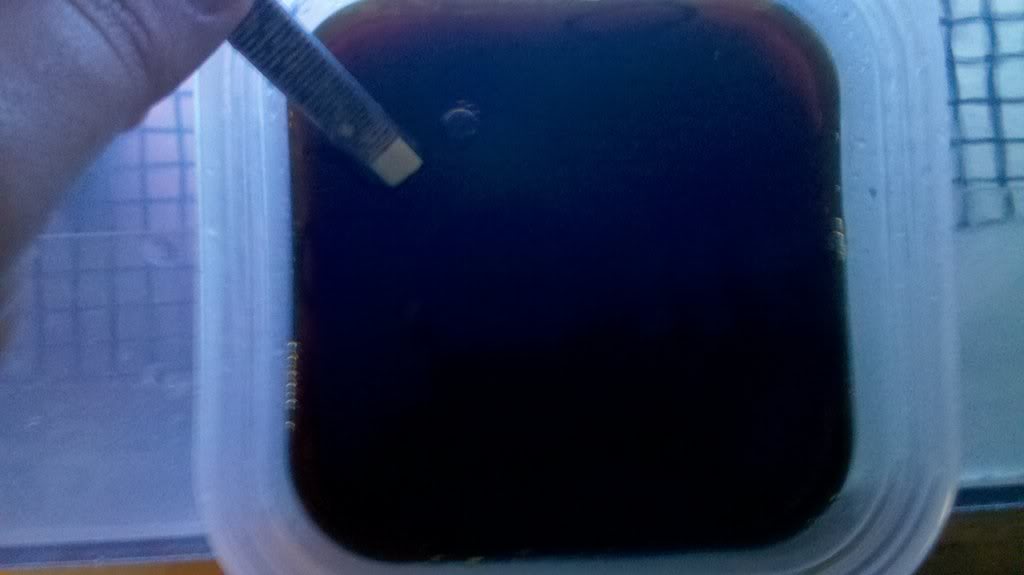
Dipping this rock of Purple Death's that haven't been happy since I moved them into way too little light and have had a rock 'nem of some sort in the colony stinging them. In this case, using the iodine dip as a bacteria/fungal infection killer (also kills many parasites/small inverts that could be harming them) while it also acts as a 'vitamin-boost' for lack of a better term as I believe the corals 'suck in' the iodide (which is a key component of coral 'flesh' )
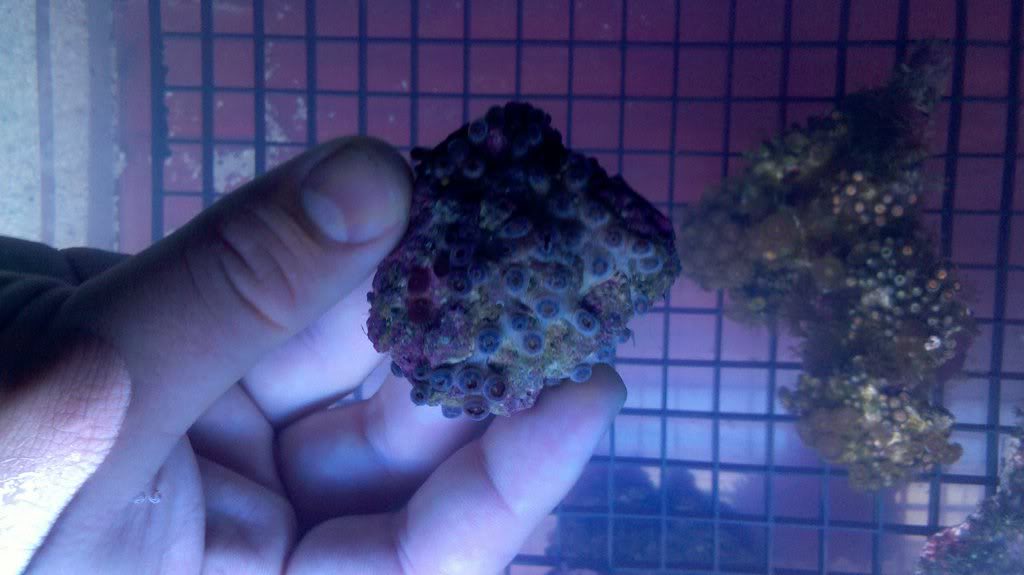
I now place the container in the tank (don't recommend doing this, I prefer using a tub with a small heater and powerhead in it) to keep the water at temperature, and clamp it in place. Depending on the severity of the problem, this way I can leave the coral up to 24 hours (zoa's only!) or even longer. If that long of a time, i will add a tiny powerhead to create some movement, or try and use a turkey baster every couple of hours to keep things stirred up. In general, LPS's get dipped for 3-20 minutes depending on severity of the problem affecting them (more severe, longer dip typically, excepting chalice's which get short time periods no matter what because they're drama queens,) Zs&Ps get a minimum of 30 minutes, typically longer if there's something good on TV (or at least good enough for my rotted brain,) and will get the 24hour+ treatment only in rare cases.
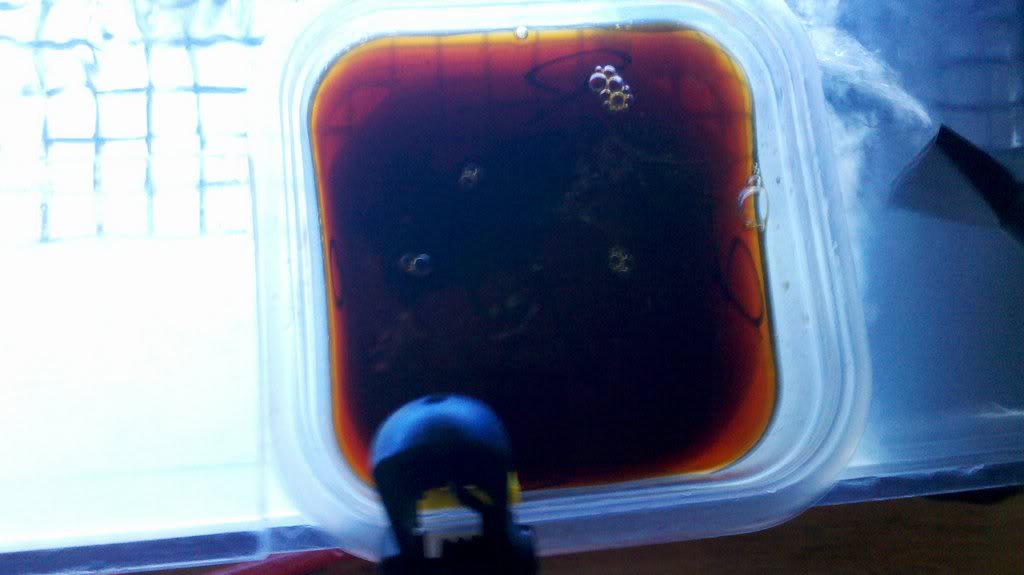
I didn't dose quite as heavily as normal, plus the zoa's being fairly damaged, along with a possible bacterial growth, have all resulted in the iodine dissipating (this is all just my belief, not scientific knowledge here folks!) Not a big deal, and i figure it's a sign that it was working. If I'm going to dip anything further, i'll either add more iodine and re-stir it up, or in this case where I didn't know the specifics of what was wrong, I'll go ahead and discard this water and start fresh (as I'm now going to be dipping some chalices, see earlier drama queen remarks)
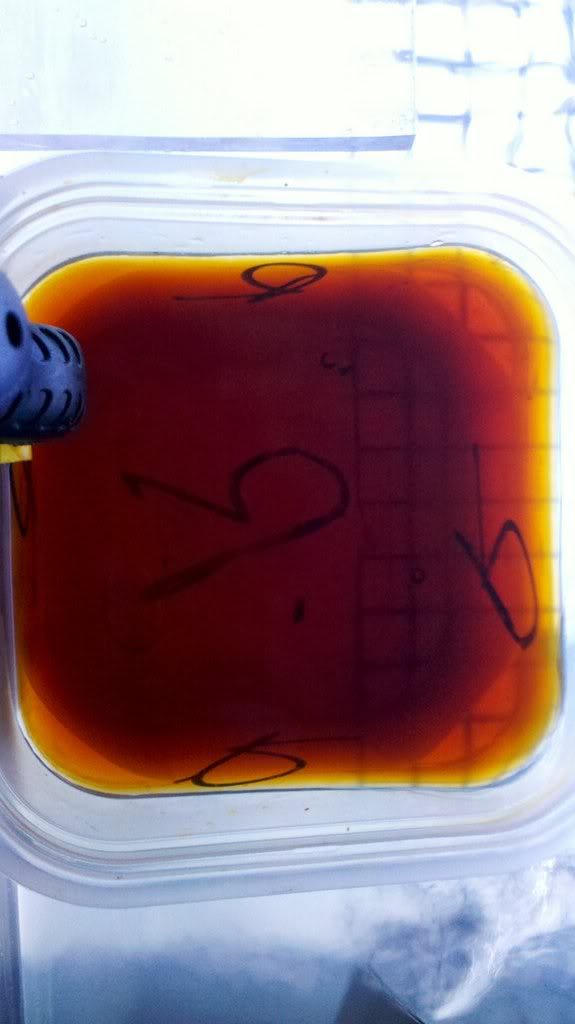
After removing from the dip, i put the coral directly back into the tank it's destined for- I've never rinsed it off in between or anything like that.
Hope that's some help guys and gals!
I typically dip LPS's and Zs&Ps depending on what's affecting them. If I don't know exactly what it is, the first dip I try is an iodine to perk them back up. I've never dipped SPS's this way on a consistent enough basis to tell you what results you'll get out of it for them, please feel free to add info if you have!
%<-GPS
Probably one of the most important pieces: The Iodine! I use CVS brand Povidone-Iodine, for all purposes that I've found, it's identical to Lugol's Solution. That said, I don't dose it to the tank, and if you choose to-blame someone else if it messes things up :angel:

Next up is the dipping container- I know a lot of people like to know exact numbers in terms of cups of water and what not, sorry, I don't do it that way, so you'll just have to bear with me. Oh, and the R's stand for 'reef' so we know it's been used for doing dips and may have weird chemicals (before we use it for soup when we've run out of dishes...)

Filled with water from the tank that the coral to be dipped came from, or is going into (if transferring to a new tank, I use the new tanks water)

Adding the iodine. I measure based on 'darkness' of the mixture, not on any specific drop count. For zoa's I go black- so dark you can't see through it. For chalices/LPSs, I'll typically go a little lighter, to the point that you could maybe just see through it under lighting. If the LPS is looking like a goner, I'll give it a stronger dose figuring "what's the worst that can happen at this point..." Sometimes it works, sometimes it doesn't
So anyways- adding the iodine, then stir in with either a spoon (i use a pair of long tweezers) or a turkey baster will work- CAUTION iodine stains really well, and you don't want it in your tank at these levels, so be careful around the tank and any precious clothing.

Stirring...

Pair of metal tweezers extending all the way to the bottom of the container. yes, THAT dark.

Dipping this rock of Purple Death's that haven't been happy since I moved them into way too little light and have had a rock 'nem of some sort in the colony stinging them. In this case, using the iodine dip as a bacteria/fungal infection killer (also kills many parasites/small inverts that could be harming them) while it also acts as a 'vitamin-boost' for lack of a better term as I believe the corals 'suck in' the iodide (which is a key component of coral 'flesh' )

I now place the container in the tank (don't recommend doing this, I prefer using a tub with a small heater and powerhead in it) to keep the water at temperature, and clamp it in place. Depending on the severity of the problem, this way I can leave the coral up to 24 hours (zoa's only!) or even longer. If that long of a time, i will add a tiny powerhead to create some movement, or try and use a turkey baster every couple of hours to keep things stirred up. In general, LPS's get dipped for 3-20 minutes depending on severity of the problem affecting them (more severe, longer dip typically, excepting chalice's which get short time periods no matter what because they're drama queens,) Zs&Ps get a minimum of 30 minutes, typically longer if there's something good on TV (or at least good enough for my rotted brain,) and will get the 24hour+ treatment only in rare cases.

I didn't dose quite as heavily as normal, plus the zoa's being fairly damaged, along with a possible bacterial growth, have all resulted in the iodine dissipating (this is all just my belief, not scientific knowledge here folks!) Not a big deal, and i figure it's a sign that it was working. If I'm going to dip anything further, i'll either add more iodine and re-stir it up, or in this case where I didn't know the specifics of what was wrong, I'll go ahead and discard this water and start fresh (as I'm now going to be dipping some chalices, see earlier drama queen remarks)

After removing from the dip, i put the coral directly back into the tank it's destined for- I've never rinsed it off in between or anything like that.
Hope that's some help guys and gals!
Last edited:




